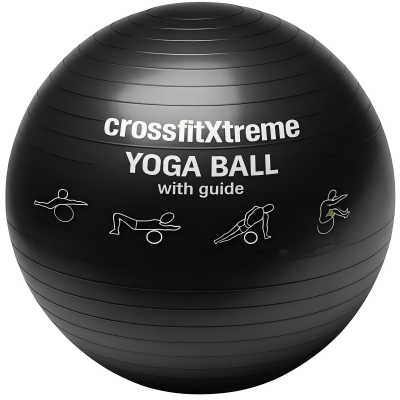Trusted OEM Manufacturer | Anti-Burst & Eco-Friendly Materials | Custom Sizes & Colors Available
What are yoga balls?
Crossfitxtreme yoga balls are balls made of soft elastic eco-friendly material, usually in multiple diameters, in 10 cm increments, from 35 cm to 95 cm, and filled with air. Change the air pressure by filling the air valve stem with air or letting the ball deflate. It is most commonly used in physical therapy, athletic training, and exercise. It can also be used for weight training. The Crossfitxtreme yoga ball is produced from environmentally friendly and non-toxic raw materials and is BPA-free.
The Crossfitxtreme yoga ball is also known by various other names such as Balance Ball, Birth Ball, Body Ball, Fitness Ball, Fitness Ball, Gymnastic Ball, Therapy Ball, Pilates Ball, Pezzie Ball, Stability Ball, Swedish Ball, Swiss Ball, Healing balls or fitness balls.
An anti-burst yoga ball is one that won’t rupture if you accidentally puncture it. The good news is that many quality balls are made of PVC, and they won’t rip or deflate when under pressure. Anti-burst yoga balls will also be safe to use during all types of exercises, and they’re designed to handle more weight than the average yoga ball.
What benefits of yoga balls?
Yoga balls, also known as exercise balls, stability balls, or Swiss balls, are versatile workout tools that can provide numerous benefits when incorporated into your fitness routine. Here are some of the key benefits of using yoga balls:
- Improved balance and stability: Yoga balls challenge your balance and stability by creating an unstable surface, forcing you to engage your core muscles to maintain proper alignment and posture.
- Increased core strength: By engaging your core muscles during exercises on a yoga ball, you can effectively strengthen your abdominals, lower back, and pelvic floor muscles, which can lead to better overall stability and posture.
- Enhanced flexibility: Using a yoga ball in your stretching routine can help improve your flexibility by supporting and extending your range of motion in various poses and stretches.
- Better muscle activation: The unstable surface of the yoga ball requires you to recruit additional stabilizing muscles during exercises, leading to more effective muscle activation and overall conditioning.
- Low-impact workouts: Many yoga ball exercises are gentle on the joints, making them suitable for individuals with joint issues or those recovering from injuries.
- Rehabilitation and injury prevention: Incorporating yoga ball exercises into your routine can help increase joint stability, promote muscle balance, and reduce the risk of injuries.
- Functional training: Yoga ball exercises often mimic real-life movements, helping to improve your functional fitness and make everyday tasks easier to perform.
- Versatility: Yoga balls can be used for a wide range of exercises, including strength training, cardio, stretching, and relaxation, making them a valuable addition to any fitness program.
Ergonomic seating: Using a yoga ball as a chair can help promote better posture, relieve lower back pain, and encourage active sitting by engaging core muscles throughout the day.
How to use yoga balls?
Using a yoga ball in your exercise routine can help improve balance, stability, and core strength. Here are some basic guidelines on how to use a yoga ball effectively and safely:
- Choose the right size: Yoga balls come in various sizes, typically ranging from 45 cm to 85 cm in diameter. Select a ball size based on your height : 45 cm: for individuals up to 5’0″ (152 cm)
55 cm: for individuals between 5’1″ and 5’7″ (155-170 cm)
65 cm: for individuals between 5’8″ and 6’2″ (173-188 cm)
75 cm: for individuals between 6’3″ and 6’7″ (190-200 cm)
85 cm: for individuals over 6’8″ (203 cm and taller)
- Inflate the ball properly: Inflate the ball until it’s firm but has some give when you press on it. When sitting on the ball, your knees should be bent at a 90-degree angle with your feet flat on the floor.
- Warm-up: Before using the yoga ball, warm up your body with light cardio exercises or dynamic stretches to increase blood flow and loosen up your muscles.
- Maintain proper form: Focus on maintaining good posture and alignment during yoga ball exercises. Engage your core muscles and avoid overarching your back or straining your neck.
Here are some basic exercises that incorporate the yoga ball:
Ball Squats
- Stand with your feet hip-width apart and place the yoga ball between your lower back and a wall.
- Lower into a squat position while keeping the ball in contact with your back and the wall.
- Press through your heels to return to a standing position.
- Repeat for 10-15 repetitions.
Ball Plank
- Place your forearms on the yoga ball with your elbows under your shoulders.
- Extend your legs and come into a plank position, keeping your body in a straight line from head to heels.
- Hold for 30-60 seconds, maintaining proper alignment and engaging your core muscles.
Ball Crunches
- Sit on the yoga ball with your feet flat on the floor and your hands behind your head.
- Lean back, allowing the ball to support your lower back, and engage your core muscles.
- Lift your upper body towards your knees while keeping your lower back in contact with the ball.
- Lower back down to the starting position.
- Repeat for 10-15 repetitions.


